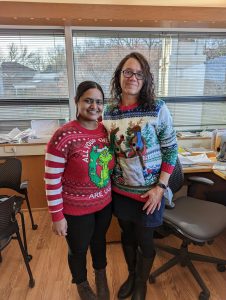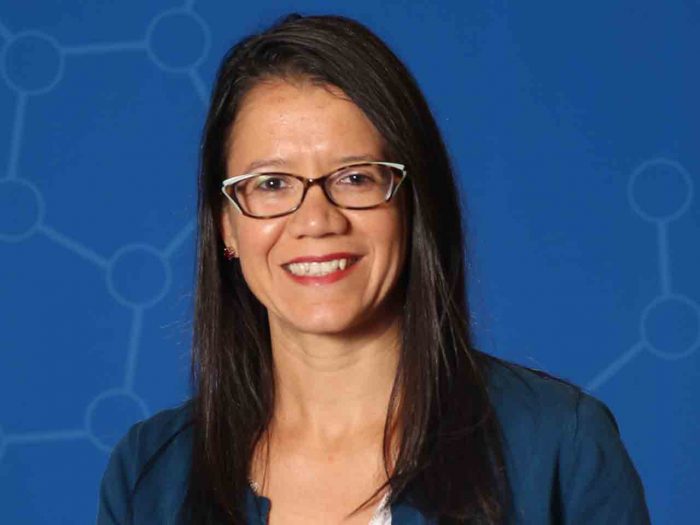CSHL’s Camila dos Santos links pregnancy protein to defense against breast cancer
By Daniel Dunaief
Pregnancy and lactation can alter genes in specific mammary cells, which may have implications in a defense against cancer.
In mouse models, mice that became pregnant at a young age have so-called epigenetic changes that survive for the animal life span and some of those are linked to a decrease in breast cancer.
In a recent study published in Cell Reports, Cold Spring Harbor Associate Professor Camila dos Santos and her graduate student Amritha Varshini Hanasoge Somasundara found that a protein involved in mammary cells in mice, called CD1d, boosts the immune system after a full pregnancy cycle, protecting it against breast cancer.
“Our research demonstrated that increased levels of CD1d in breast cells serve as a signal to recruit higher numbers of specialized immune cells” called natural killer T-cells, or NKT, “to come and reside within the breast tissue after pregnancy,” dos Santos explained in an email. These NKTs are part of mechanisms that reduce breast cancer risk after pregnancy.
Dos Santos would like to understand the molecular changes that occur from pregnancy and hopes one day to adapt them in the form of a vaccination or pill to decrease the risk of breast cancer.
To be sure, numerous questions about the process of using the immune system to prevent cancer remain, which means that the development of such a preventive pill requires considerable additional research.
Dos Santos has spent the last eight years developing model systems that allow her to discover pregnancy-induced changes that could lead to preventive strategies.
Enhancing the communication between epithelial and immune cells could represent a way to decrease breast cancer development and even treat cases of developed cancer.
To get to that point, dos Santos, the members of her lab, and her collaborators plan to make discoveries like this one to understand the dynamic interaction between the cascade of molecular interactions from pregnancy and the genetic and immunological reactions.
Humans have four CD1 genes, which all play a similar role in immunity. Additionally, there are several types of NKT cells, and each of them has a different immunological function, which means that any prevention or treatment that tapped into this system would need to bring the right CD1 molecule and the right NKT cells.
It is not yet clear whether enhancing CD1 signals protect women who might have a predisposition to breast cancer. Dos Santos is currently exploring this question in animals.
While dos Santos is focusing specifically on pregnancy-driven changes in the mammary gland, she acknowledged that altering CD1d levels in other organs might also decrease other types of cancer.
Dos Santos described pregnancy as being akin to turning on a light. First, during the course of gestation, pregnancy brightens that light to the top. After birth, the dimmer goes to the middle, leaving the system in a different state, which is not only more prepared for the next pregnancy but also to defend itself against alterations like cancer.
In most pregnancy mammary cells in mice, the scientists found a 10-fold increase in the abundance of NKT cells when compared to cells from an individual who had never been pregnant.
When the researchers removed the CD1d protein in mice, they found an association between the absence or low expression and the development of tumors in the breast.
Dos Santos and Hanasoge hypothesize that this protein is recruiting immune cells to monitor breast cells after pregnancy. If the epithelial cells develop cancer, the NKT cells may kill them, preventing the development and advancement of cancer.
In addition to working with mouse models of pregnancy, dos Santos is collaborating with Northwell Health to study cells from healthy women who are undergoing cosmetic surgery. They are analyzing that data, which wasn’t in this paper.
Dos Santos is investigating several questions, including how the age at pregnancy influences breast tissue. She is creating organoids, which are three-dimensional models of breast cells that react to change in their environment
Joining a family

Amritha Varshini Hanasoge Somasundara, who has been a part of dos Santos’s lab for over two years, explained that she felt comfortable and supported instantly when she arrived. She described the atmosphere as extremely collegial and felt as if she were included in a scientific family.
Joining dos Santos’s group was “possibly the best decision I’ve ever made,” said Hanasoge. Dos Santos’s lab is a “really special place” where lab members often have lunch together and support each other’s research.
Hanasoge was drawn to Dos Santos’s mentorship and the overall lab dynamic. Scientifically, she was also interested in the immunology project, exploring NKT cells. Her main project has involved trying to characterize NKT cells further.
Hanasoge sees plenty of opportunities to address additional questions in this field. “We don’t know if the process of lactation is causing more CD1d and increasing expression,” she said. “We are still trying to characterize what T-cell receptors are being expressed after pregnancy.”
A resident of Syosset, Hanasoge enjoys reading and said she was fascinated by science when she was growing up in Mysore, Kamataka in India. She asked her parents for a microscope when she was around seven and used it to looked at flower petals and leaves. That toy microscope, which her parents purchased from a science museum in Mumbai, is still in her parent’s house.
Hanasoge is eager to combine basic and translational work and hopes her research has a clinical benefit. She is looking forward to the next steps in her research in dos Santos’s lab.
“I learn from her every day by watching how she interacts with people she mentors, both inside the lab and out,” Hanasoge explained in an email. “Her passion and commitment to being a good mentor and her drive to ask the right questions in our research are inspiring.”







